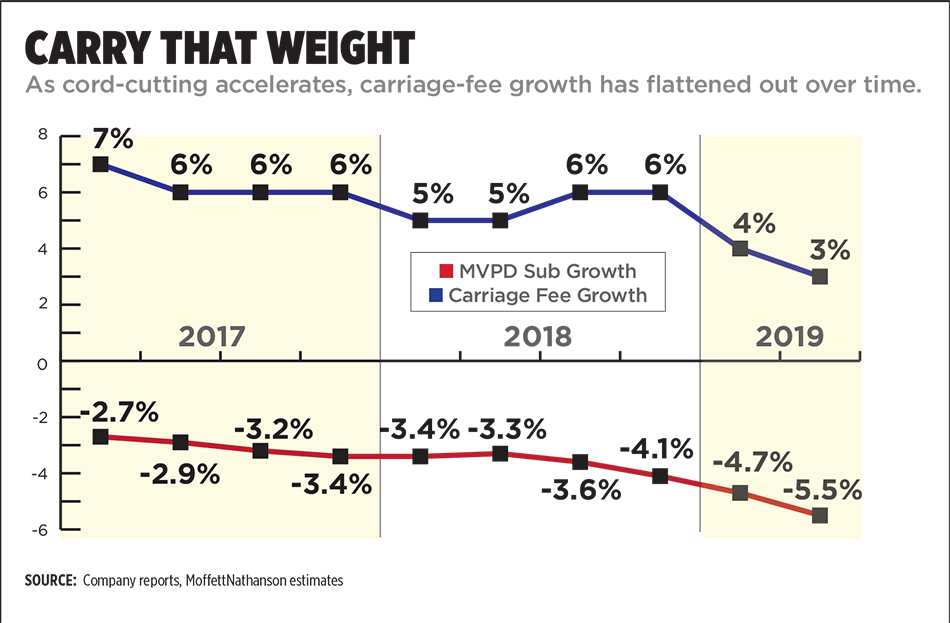Cord-Cutting Starts to Pinch Affiliate Fees
Cord-cutting continued to accelerate in the second quarter, and programmers are beginning to feel the bite from lower affiliate fees.
The major publicly traded pay TV distributors lost a collective 1.25 million customers in the second quarter, much more than the 134,000 lost in the same period last year.
Most of those losses were from satellite TV. AT&T led the losers, shedding nearly 1 million customers from its three pay TV services — DirecTV, AT&T Now (formerly DirecTV Now) and U-verse TV — followed by less-dramatic declines at Comcast (224,000 vs. 140,000 last year) and Charter Communications (150,000 vs. 73,000 last year). Altice USA, which reported Q2 results July 31, slightly improved its video customer losses in the quarter to 21,000 from 24,000 a year ago.

According to MoffettNathanson media analyst Michael Nathanson, the pace of cord-cutting is expected to accelerate to a record 5.5% in Q2. Adding back gains from virtual MVPDs improves the losses to 2.7%, still a new low. Nathanson said in a research note that “the early read on traditional cord-cutting is freaking ugly.”
As for the two national satellite-TV platforms, the sharp decline at DirecTV contrasted with better-than-expected results at Dish Network, which lost about 79,000 satellite TV customers but gained 48,000 Sling TV OTT subscribers in the period. Dish’s satellite losses were an improvement over the 150,000 subscribers it lost in Q2 2018, largely due to DirecTV customers who were rolling off promotional discounts switching to the lower-priced Dish service.
MoffettNathanson principal and senior analyst Craig Moffett called Dish’s results a double-edged sword. Despite the subscriber improvement, Dish revenue is shrinking at a rate of 7.2% and total subscribers are declining at a 10.3% annual pace. While cash-flow growth was still fairly healthy at $580 million in Q2, it declined about 22.1% in the period, according to the analyst, partly due to an increase in gross subscriber additions (which carry higher costs).
“Notwithstanding the lower-than-expected subscriber losses, those metrics are scary,” Moffett wrote.
Multichannel Newsletter
The smarter way to stay on top of the multichannel video marketplace. Sign up below.
If Dish investors should be scared, content shareholders should be downright terrified.
Analysts have been waiting for the other cord-cutting shoe to drop, as fewer pay TV subscribers would logically lead to lower carriage fees. So far, carriage on OTT and SVOD platforms, affiliate-fee increases and the relatively slow pace of pay TV customer declines — 2% to 3% over the past year or so — have helped keep overall affiliate-fee growth in line. That may be coming to an end, as cord cutting is on pace to top 5.5% in Q2, its highest level ever, according to MoffettNathanson.
Zombie Apocalypse at AMC?
The first casualty of the new cord-cutting environment could be AMC Networks, home to the most-watched show on cable — The Walking Dead — and which mosts analysts believe showed a decline in affiliate fees in the second quarter. With other major programmers scheduled to report results in the next few weeks, the potential for a torrent of bad news is high.
AMC Networks doesn’t break out affiliate-fee revenue, instead lumping it into “Distribution,” which also includes content licensing revenue, up 1% in the period. But some analysts have estimated that given company guidance that content licensing increased during the quarter (most likely in the mid-single-digits, according to Evercore ISI Group media analyst David Joyce), affiliate-fee revenue was either flat or down. In a July 31 note to clients, Joyce wrote that “could be a negative omen for the industry reflecting the subscriber declines that reaccelerated this year.”
Whatever the case, Sanford Bernstein media analyst Todd Juenger said AMC missed expectations for Distribution revenue for the third consecutuve quarter by a fairly wide margin. The consensus expectation was a 5% increase. “Affiliate fees seem to have surely decelerated, probably negative year-over-year, mostly due to awful pay TV sub trends, as well as [AMC Networks’] loss of distribution on new DirecTV Now packages,” he wrote in a research note.
Things could get worse. Juenger said AMC has been silent on when its major carriage deals expire, but he suspects it will be soon, given a burst of renewals in 2012 and 2013. Deals are usually for five to seven years.
On an earnings call with analysts on July 31, AMC CEO Josh Sapan said several multi-year carriage renewals were signed this year, and AMC believes it is “very, very well-positioned” due to its price and the strength of its content.
Asked directly about more details on affiliate-fee revenue on the call, Sapan said MVPD subscriber growth has been trending down.
“As we are paid on individual units of subscribers, that affects us,” Sapan said.
Nathanson cautioned earlier that affiliate-fee growth could be in trouble. In a July 29 note he wrote that, after two straight quarters of 6% growth, carriage fees increases dipped to 4% in Q1 and are expected to do the same in Q2. “This will likely be the weakest cable-network affiliate-fee growth quarter on record,” Nathanson noted.
